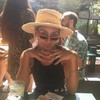J Davies, from the series Love Story, 2022, at Queering the Frame: Community, Time, Photography at the Centre for Contemporary Photography as part of PHOTO 2022 International Festival of Photography. Courtesy the artist/Photo Australia.
Florian Hetz’s from his Augmented Reality exhibition ‘Haut’. Photography as part of PHOTO 2022 International Festival of Photography. Courtesy the artist/Photo Australia.
J Davies, from the series Love Story, 2022, at Queering the Frame: Community, Time, Photography at the Centre for Contemporary Photography as part of PHOTO 2022 International Festival of Photography. Courtesy the artist/Photo Australia.
Florian Hetz’s From Augmented Reality exhibition ‘Haut’. Photography as part of PHOTO 2022 International Festival of Photography. Courtesy the artist/Photo Australia.
J Davies, from the series Love Story, 2022, at Queering the Frame: Community, Time, Photography at the Centre for Contemporary Photography as part of PHOTO 2022 International Festival of Photography. Courtesy the artist/Photo Australia.
Florian Hetz’s From Augmented Reality exhibition ‘Haut’. Photography as part of PHOTO 2022 International Festival of Photography. Courtesy the artist/Photo Australia.
Florian Hetz’s From Augmented Reality exhibition ‘Haut’. Photography as part of PHOTO 2022 International Festival of Photography. Courtesy the artist/Photo Australia.
J Davies, from the series Love Story, 2022, at Queering the Frame: Community, Time, Photography at the Centre for Contemporary Photography as part of PHOTO 2022 International Festival of Photography. Courtesy the artist/Photo Australia.
J Davies, from the series Love Story, 2022, at Queering the Frame: Community, Time, Photography at the Centre for Contemporary Photography as part of PHOTO 2022 International Festival of Photography. Courtesy the artist/Photo Australia.
J Davies, from the series Love Story, 2022, at Queering the Frame: Community, Time, Photography at the Centre for Contemporary Photography as part of PHOTO 2022 International Festival of Photography. Courtesy the artist/Photo Australia.
J Davies, from the series Love Story, 2022, at Queering the Frame: Community, Time, Photography at the Centre for Contemporary Photography as part of PHOTO 2022 International Festival of Photography. Courtesy the artist/Photo Australia.
J Davies, from the series Love Story, 2022, at Queering the Frame: Community, Time, Photography at the Centre for Contemporary Photography as part of PHOTO 2022 International Festival of Photography. Courtesy the artist/Photo Australia.
J Davies, from the series Love Story, 2022, at Queering the Frame: Community, Time, Photography at the Centre for Contemporary Photography as part of PHOTO 2022 International Festival of Photography. Courtesy the artist/Photo Australia.
J Davies, from the series Love Story, 2022, at Queering the Frame: Community, Time, Photography at the Centre for Contemporary Photography as part of PHOTO 2022 International Festival of Photography. Courtesy the artist/Photo Australia.
J Davies, from the series Love Story, 2022, at Queering the Frame: Community, Time, Photography at the Centre for Contemporary Photography as part of PHOTO 2022 International Festival of Photography. Courtesy the artist/Photo Australia.
J Davies, from the series Love Story, 2022, at Queering the Frame: Community, Time, Photography at the Centre for Contemporary Photography as part of PHOTO 2022 International Festival of Photography. Courtesy the artist/Photo Australia.
J Davies, from the series Love Story, 2022, at Queering the Frame: Community, Time, Photography at the Centre for Contemporary Photography as part of PHOTO 2022 International Festival of Photography. Courtesy the artist/Photo Australia.
J Davies, from the series Love Story, 2022, at Queering the Frame: Community, Time, Photography at the Centre for Contemporary Photography as part of PHOTO 2022 International Festival of Photography. Courtesy the artist/Photo Australia.
J Davies, from the series Love Story, 2022, at Queering the Frame: Community, Time, Photography at the Centre for Contemporary Photography as part of PHOTO 2022 International Festival of Photography. Courtesy the artist/Photo Australia.
J Davies, from the series Love Story, 2022, at Queering the Frame: Community, Time, Photography at the Centre for Contemporary Photography as part of PHOTO 2022 International Festival of Photography. Courtesy the artist/Photo Australia.
J Davies, from the series Love Story, 2022, at Queering the Frame: Community, Time, Photography at the Centre for Contemporary Photography as part of PHOTO 2022 International Festival of Photography. Courtesy the artist/Photo Australia.
J Davies, from the series Love Story, 2022, at Queering the Frame: Community, Time, Photography at the Centre for Contemporary Photography as part of PHOTO 2022 International Festival of Photography. Courtesy the artist/Photo Australia.
J Davies, from the series Love Story, 2022, at Queering the Frame: Community, Time, Photography at the Centre for Contemporary Photography as part of PHOTO 2022 International Festival of Photography. Courtesy the artist/Photo Australia.
J Davies, from the series Love Story, 2022, at Queering the Frame: Community, Time, Photography at the Centre for Contemporary Photography as part of PHOTO 2022 International Festival of Photography. Courtesy the artist/Photo Australia.
